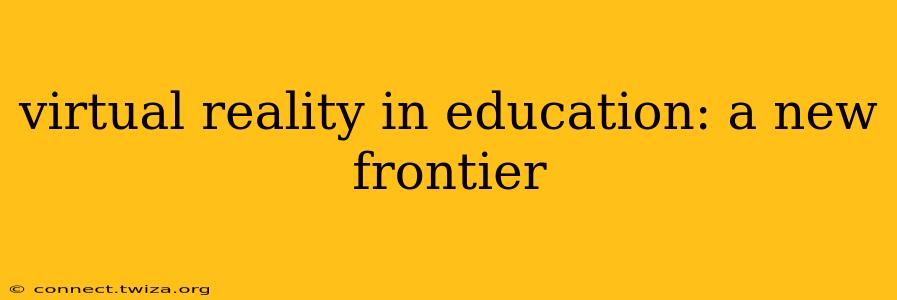Virtual Reality (VR) is rapidly transforming numerous sectors, and education is no exception. This immersive technology offers unparalleled opportunities to enhance learning experiences, making education more engaging, accessible, and effective. From interactive history lessons to hands-on science experiments, VR is poised to revolutionize how we teach and learn. This article delves into the exciting potential of VR in education, exploring its benefits, challenges, and future implications.
What are the benefits of using VR in education?
The advantages of integrating VR into educational settings are numerous. Firstly, VR fosters immersive learning, transporting students to historical events, distant lands, or even the human body, offering a level of engagement far surpassing traditional methods. Secondly, VR promotes active learning. Instead of passively absorbing information, students actively participate in simulations, experiments, and problem-solving scenarios, solidifying their understanding. Thirdly, VR enhances accessibility. It can bridge geographical barriers, allowing students in remote areas to access enriching educational experiences previously unavailable. Finally, VR provides a safe and controlled environment for learning, allowing students to practice complex procedures or explore dangerous situations without risk.
How can VR be used in different subjects?
VR's versatility extends across various subjects. In history, students can virtually visit ancient Rome or witness pivotal historical events firsthand. Science classes can leverage VR to explore the human body's intricate systems or conduct virtual dissections without ethical concerns. Geography lessons can transport students to different continents, exploring diverse landscapes and cultures. Even language learning benefits, as VR creates immersive environments for practicing conversational skills. The possibilities are truly limitless.
What are the challenges of implementing VR in education?
Despite the immense potential, integrating VR into education faces challenges. Cost is a significant barrier, with VR headsets and software representing a considerable investment for schools. Technical issues such as glitches, compatibility problems, and the need for robust internet infrastructure can hinder implementation. Furthermore, the development of high-quality educational VR content remains an ongoing process. Finally, ensuring equitable access for all students, regardless of their socioeconomic background, is crucial for avoiding a digital divide.
Is VR effective for learning?
Studies are increasingly demonstrating the effectiveness of VR in education. Research shows that VR can improve student engagement, knowledge retention, and problem-solving skills. However, it's important to acknowledge that VR is not a replacement for traditional teaching methods; rather, it serves as a powerful supplementary tool, enhancing and enriching the learning experience. The effectiveness of VR largely depends on its thoughtful integration into the curriculum and the quality of the educational content developed.
How much does VR technology cost for education?
The cost of VR technology in education varies significantly based on the type of hardware, software, and the scale of implementation. From individual headsets costing a few hundred dollars to comprehensive classroom setups requiring thousands, schools need to carefully assess their budget and prioritize their needs. Exploring options like renting or leasing VR equipment can also be cost-effective strategies.
What are the future trends in VR education?
The future of VR in education is bright, with ongoing developments promising even greater possibilities. We can anticipate advancements in haptic feedback, making virtual experiences even more realistic and immersive. Increased accessibility through more affordable hardware and software is also expected. Furthermore, the development of more sophisticated educational VR content will cater to a wider range of subjects and learning styles. Finally, the integration of artificial intelligence (AI) will personalize learning experiences, adapting to individual student needs and progress.
Conclusion
Virtual reality holds transformative potential for education, fostering engaging, accessible, and effective learning experiences. While challenges remain in terms of cost and implementation, the benefits of VR outweigh the drawbacks. As technology continues to advance and costs decrease, the widespread integration of VR in education is likely to become a reality, revolutionizing how future generations learn and grow.
